Related Research Articles
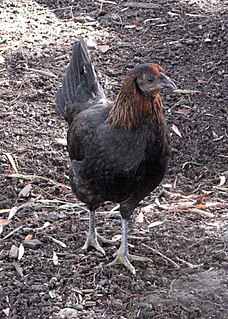
The American Game is an American breed of game fowl, chickens bred specifically for cockfighting. It has many color varieties, and may also be kept for ornament.
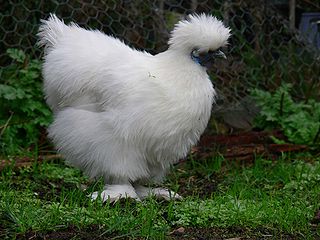
The Silkie is a breed of chicken named for its atypically fluffy plumage, which is said to feel like silk and satin. The breed has several other unusual qualities, such as black skin and bones, blue earlobes, and five toes on each foot, whereas most chickens only have four. They are often exhibited in poultry shows, and also appear in various colors. In addition to their distinctive physical characteristics, Silkies are well known for their calm, friendly temperament. It is among the most docile of poultry. Hens are also exceptionally broody, and care for young well. Although they are fair layers themselves, laying only about three eggs a week, they are commonly used to hatch eggs from other breeds and bird species due to their broody nature.

The Sussex is a British breed of dual-purpose chicken, reared both for its meat and for its eggs. Eight colours are recognised for both standard-sized and bantam fowl. A breed association, the Sussex Breed Club, was organised in 1903.
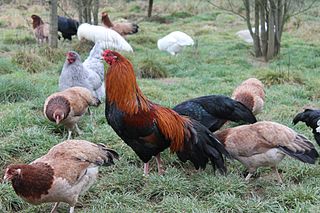
The Cubalaya is a Cuban breed of domestic chicken. It is the only chicken breed with official recognition from the Asociación Nacional de Avicultura, the Cuban national poultry association. It derives from Sumatra and Malay birds brought to Cuba from the Philippines, and was bred as a triple-purpose breed, for meat, eggs and cock-fighting.

The Dominique is an American breed of chicken, characterized by black-and-white barred plumage and a rose comb. It is considered to be the oldest American chicken breed, and is thought to derive from birds brought to America by colonists from southern England. It was well known by about 1750, and by the mid-nineteenth century was widely distributed in the eastern United States. It is a dual-purpose breed, but is kept principally for its brown eggs. It became an endangered breed in the twentieth century, but numbers have since recovered.
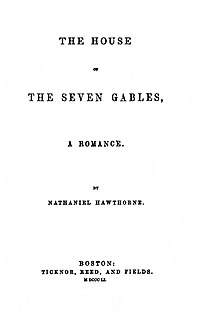
The House of the Seven Gables: A Romance is a Gothic novel written beginning in mid-1850 by American author Nathaniel Hawthorne and published in April 1851 by Ticknor and Fields of Boston. The novel follows a New England family and their ancestral home. In the book, Hawthorne explores themes of guilt, retribution, and atonement, and colors the tale with suggestions of the supernatural and witchcraft. The setting for the book was inspired by the Turner-Ingersoll Mansion, a gabled house in Salem, Massachusetts, belonging to Hawthorne's cousin Susanna Ingersoll, as well as ancestors of Hawthorne who had played a part in the Salem Witch Trials of 1692. The book was well received upon publication and later had a strong influence on the work of H. P. Lovecraft. The House of the Seven Gables has been adapted several times to film and television.

The Ancona is a breed of chicken which originated in the Marches, region of Italy, but which was bred to its present type mainly in the United Kingdom in the nineteenth century. It is named after the city of Ancona, capital of the Marche. It is popular in Britain and the United States, but uncommon in Italy; an initiative to re-establish it in its native area and preserve its biodiversity was launched in 2000. There are also Ancona bantams.
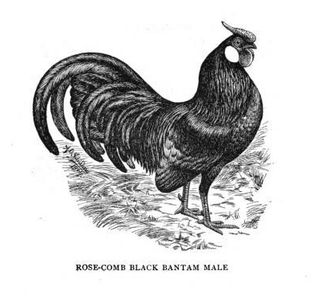
The Rosecomb is a breed of chicken named for its distinctive comb. Rosecombs are bantam chickens, and are among those known as true bantams, meaning they are not a miniaturised version of a large fowl. Rosecombs are one of the oldest and most popular bantam breeds in showing, and thus have numerous variations within the breed. An ornamental chicken, they are poor egg layers and not suited for meat production.
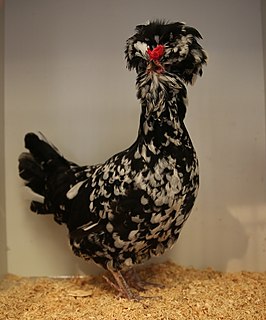
The Houdan or Poule de Houdan is an old French breed of domestic chicken. It is named for its area of origin, the commune of Houdan, in the département of Yvelines to the west of Paris. It belongs to the crested chicken group, is muffed and bearded, has an unusual leaf-shaped comb, and has five toes on each foot rather than the usual four.

The Dutch Bantam is a breed of bantam chicken originating in the Netherlands. It is a true bantam, a naturally small bird with no related large fowl from which it was miniaturized. It is kept mainly for exhibition, and has been bred in many color varieties; it is a good layer of small eggs.
The Nankin Bantam or Nankin is a British bantam breed of chicken. It is a true bantam, a naturally small breed with no large counterpart from which it was miniaturised. It is of South-east Asian origin, and is among the oldest bantam breeds. It is a yellowish buff colour, and the name is thought to derive from the colour of nankeen cotton from China.

The Rhode Island White is a breed of chicken originating in the U.S. state of Rhode Island. Despite their very similar names and shared place of origin, the Rhode Island White is a distinct breed from the Rhode Island Red. However, Rhode Island Reds and Whites can be bred together to create Red Sex-Link hybrid chickens, such as the ISA Brown. In Australia, the Rhode Island White is regarded as a colour variety of the Rhode Island breed according to the Australian Poultry Standards.

The Sultan is a Turkish breed of crested chicken. The name derives from the original Turkish language name of Serai-Tavuk, which translates as "fowls of the Sultan". They have always been primarily ornamental, having been kept in the gardens of Ottoman sultanate. In the West they are bred for competitive showing as part of poultry fancy, and are generally a rare sight.
The Iowa Blue is a breed of chicken that originated near Decorah, Iowa, in the early twentieth century. Despite its name, the breed is not actually blue according to poultry standards. It is an exceedingly rare fowl, and is not recognized for showing by the American Poultry Association. They are a dual-purpose breed laying brown eggs and known to be good foragers.
The Ixworth is an English breed of white domestic chicken. It is named for the village of Ixworth in Suffolk, where it was created in 1932. It was bred as fast-growing high-quality meat breed with reasonable laying abilities.

The Brabanter is a Dutch breed of crested chicken originating in the historic region of Brabant which straddles Belgium and the Netherlands. It is an ancient breed and is shown in 17th-century paintings. A bantam Brabanter was created in around 1934.

The Vorwerk is a breed of chicken originating in Germany. Though it is unrelated to the German company which produces the Vorwerk vacuum cleaner, it is the only chicken to share its name with a brand of household appliance. A rare fowl, it has distinctive black-and-gold plumage.

The Friesian or Frisian, Dutch: Fries Hoen, is an ancient Dutch breed of chicken. It originates in Friesland, on the North Sea coast of the northern Netherlands.
The Oxford Old English Game is an ancient breed of chicken, originating from Britain. They were officially recognised when The Old English Game Club split, creating two breeds of Old English Game fowl. They are primarily farmed for meat but have been used for cock fighting and eggs on a domestic scale.
References
- 1 2 3 4 5 6 Brian Heldberg (February 7, 2013). Pyncheon Bantams. Backyard Poultry Magazine.
- ↑ Damerow, Gail (31 January 2012). The chicken encyclopedia. North Adams, MA: Storey Pub. p. 219. ISBN 978-1-60342-561-2.
- 1 2 3 Hawthorne, Nathaniel (1983). Novels (1. print ed.). New York, NY: Literary Classics of the United States. ISBN 0-940450-08-9.